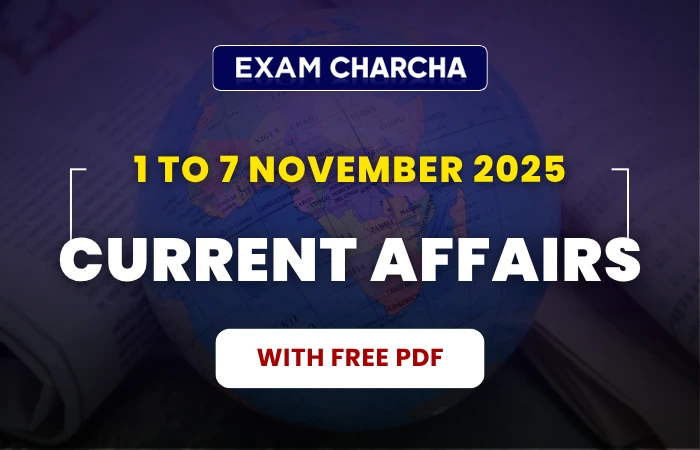
Find the Weekly Current Affairs for the 1st week of November 2025. Stay informed with the most important news and events from around the world. Our curated updates provide a comprehensive summary of the week’s key happenings, covering politics, economics, science, technology, sports, and international affairs.
Designed for competitive exam aspirants, these weekly current affairs help you stay updated and enhance your general knowledge. Each week, we offer summaries, in-depth information in the form of downloadable free PDFs for easy revision.
Keep your preparation on track with our expert-curated content, ensuring you are always ready for your exams.
Highlights of November 1st Week Current Affairs
- The MoFPI is strengthening the ICCVAI Scheme under PMKSY to build integrated cold chains and reduce post-harvest losses.
- The scheme promotes farm-to-consumer cold infrastructure, value addition, and year-round food safety.
- It benefits farmers, FPOs, SHGs, PSUs, and private firms, complementing schemes like AIF and MIDH.
- China filed a WTO complaint against India’s PLI schemes for EVs and batteries, citing violation of subsidy rules.
- China alleges India’s domestic value addition criteria breach WTO’s SCM Agreement by favouring local goods.
- India’s PLI scheme, launched in 2020, aims to boost manufacturing, attract FDI, and promote self-reliance.
- The Cabinet Secretary chaired an NCMC meeting after Bay of Bengal cyclones; the body now has statutory status.
- NCMC coordinates national disaster response and works closely with NDMA and central ministries.
- The Climate Inequality Report 2025 shows the top 1% emit 15% of global emissions, with vast wealth-linked disparities.
- UNEP’s Adaptation Gap Report 2025 warns of a $310–365 billion annual finance gap for developing nations, urging urgent climate action
- The U.S. and China met at the APEC Summit in Busan, where the U.S. cut tariffs by 10% and China extended a pause on rare earth export controls, signaling a potential thaw in tensions.
- The “G-2” rhetoric resurfaced, hinting at U.S.–China co-leadership in global governance, which could diminish the strategic role of India and the Global South.
- Ocean-based Carbon Capture, Utilisation, and Storage (CCUS) emerged as a key decarbonisation strategy, offering vast and durable CO₂ storage under the seabed but facing high costs and early-stage technology challenges.
- Satellite studies showed severe land subsidence in Delhi, Mumbai, Kolkata, Bengaluru, and Chennai due to over-extraction of groundwater, endangering infrastructure and increasing flood risks.
- The U.S. granted India a six-month sanctions waiver for the Chabahar Port project in Iran, recognizing its strategic role in regional trade and connectivity to Afghanistan and Central Asia.
- The Model Youth Gram Sabha initiative was launched to promote youth participation in local governance, aligning with NEP 2020 and implemented in JNVs, EMRSs, and state schools.
- The Ministry of Ports introduced “Digi Bandar,” a national digital framework to make Indian ports smart, data-driven, and AI-enabled, improving logistics, efficiency, and transparency.
- MoSPI initiated a base revision of the Consumer Price Index (CPI) to reflect updated consumption patterns and proposed including rural housing costs for better inflation accuracy.
- The Kunming Biodiversity Fund, launched by China and UNEP, began financing developing nations to implement the Kunming–Montreal Global Biodiversity Framework goals like the “30×30” conservation target.
- The Madras High Court recognized cryptocurrency as a form of property, granting investor protection and setting a precedent for digital asset ownership under Indian law.
- India and the U.S. signed a 10-year defence framework at ADMM-Plus 2025, building on previous agreements to deepen military cooperation and technology sharing.
- Foundational agreements like LEMOA, COMCASA, ISA, and BECA facilitate logistics, secure communications, industrial security, and geospatial data exchange.
- The defence partnership includes $20+ billion in procurement, co-production, and initiatives like INDUS X and ASIA to boost innovation and autonomous systems.
- Bilateral and multilateral exercises like Yudh Abhyas, Vajra Prahar, Cope India, and Malabar enhance operational interoperability between India and the U.S.
- India Maritime Week 2025 secured ₹12 lakh crore investment, expanding shipbuilding, vessel numbers, and port capacities, aligning with Maritime Amrit Kaal Vision 2047.
- Initiatives under Maritime India Vision 2030 and Sagarmala Programme aim to improve port efficiency, logistics, eco-friendly operations, and maritime security in the Indo-Pacific.
- India’s quasi-federal structure faces strains due to fiscal centralisation, administrative centralisation, and Centre-State tensions despite platforms like GST Council and NITI Aayog.
- Sardar Vallabhbhai Patel’s 150th birth anniversary was commemorated as Rashtriya Ekta Diwas, honoring his role in integrating princely states and building a unified India.
- Arya Samaj’s 150th foundation anniversary highlighted its social, educational, and reformist contributions, promoting equality, rationalism, and women’s empowerment.
- Lucknow was designated UNESCO Creative City of Gastronomy, the Iberian lynx had its first white sighting in Spain, and the 2025 APEC Summit focused on regional economic integration and trade.
- The Survey of India launched the National Geo-Spatial Platform (NGP) to implement the National Geospatial Policy, 2022, enabling unified, standardized geospatial data sharing and management.
- The NGP will support sectors like agriculture, logistics, urban planning, and disaster management through high-accuracy, interoperable spatial datasets and APIs.
- ISRO successfully launched GSAT-7R (CMS-03), India’s heaviest defence communication satellite, strengthening the Navy’s maritime domain awareness and secure communication.
- The GSAT-7R launch aboard LVM3 showcased India’s self-reliance in defence-space technology, enhancing real-time naval coordination and strategic capabilities.
- China achieved the world’s first thorium-to-uranium conversion in a molten salt reactor, marking a breakthrough in safer, efficient, and sustainable nuclear power generation.
- India continues advancing its thorium-based nuclear programme, with projects like AHWR and IMSBR leveraging the country’s vast monazite reserves.
- The NCLAT ruled that the Competition Commission of India (CCI) lacks jurisdiction over patent disputes, affirming that such matters fall solely under the Patents Act, 1970.
- The judgment clarified the legal boundary between competition law and intellectual property rights, ensuring specialized adjudication of patent cases.
- India’s first Silicon Carbide (SiC) semiconductor facility was launched in Odisha, boosting domestic chip manufacturing and supporting the Aatmanirbhar Bharat mission.
- Coal India Limited marked 50 years of operations, continuing to supply 80% of India’s coal, and India’s women’s cricket team won its first-ever ICC Women’s World Cup, defeating South Africa.
- The Survey of India launched the National Geo-Spatial Platform (NGP) to implement the National Geospatial Policy, 2022, enabling unified, standardized geospatial data sharing and management.
- The NGP will support sectors like agriculture, logistics, urban planning, and disaster management through high-accuracy, interoperable spatial datasets and APIs.
- ISRO successfully launched GSAT-7R (CMS-03), India’s heaviest defence communication satellite, strengthening the Navy’s maritime domain awareness and secure communication.
- The GSAT-7R launch aboard LVM3 showcased India’s self-reliance in defence-space technology, enhancing real-time naval coordination and strategic capabilities.
- China achieved the world’s first thorium-to-uranium conversion in a molten salt reactor, marking a breakthrough in safer, efficient, and sustainable nuclear power generation.
- India continues advancing its thorium-based nuclear programme, with projects like AHWR and IMSBR leveraging the country’s vast monazite reserves.
- The NCLAT ruled that the Competition Commission of India (CCI) lacks jurisdiction over patent disputes, affirming that such matters fall solely under the Patents Act, 1970.
- The judgment clarified the legal boundary between competition law and intellectual property rights, ensuring specialized adjudication of patent cases.
- India’s first Silicon Carbide (SiC) semiconductor facility was launched in Odisha, boosting domestic chip manufacturing and supporting the Aatmanirbhar Bharat mission.
- Coal India Limited marked 50 years of operations, continuing to supply 80% of India’s coal, and India’s women’s cricket team won its first-ever ICC Women’s World Cup, defeating South Africa.
- FAO’s SOFA 2025 report highlights human-driven land degradation reducing crop yields, threatening food security, and stressing ecosystems globally.
- Around 1.7 billion people live in regions with 10% lower crop yields due to degradation, with Asia most affected, and 47 million children under five face stunting.
- QS Asia University Rankings 2026 listed 7 Indian institutes in the top 100, with IIT Delhi ranked 59th and India now having 294 universities in the rankings.
- Amul and IFFCO were ranked the world’s top two cooperatives, highlighting India’s cooperative sector contributing to economy, employment, and sustainable agriculture.
- India launched the RDI Scheme with ₹1 lakh crore to boost research, innovation, and technological self-reliance in sunrise and strategic sectors.
- The Maldives introduced a generational ban on tobacco, preventing sale to future generations as a historic public health measure.
- UNEP’s Emission Gap Report 2025 warns global warming could reach 2.3–2.5 °C, emphasizing urgent climate action and equity-based responsibility.
- Water was detected in interstellar comet 3I/ATLAS, the first such finding, offering insights into planetary system formation beyond the solar system.
- Typhoon Kalmaegi hit central Philippines, causing heavy rain and strong winds, illustrating ongoing tropical cyclone risks in the region.
- Bangladesh introduced the Typhoid Conjugate Vaccine (TCV) in its national immunization programme, and India’s VAIBHAV fellowship promotes collaboration with diaspora scientists.
- India released the AI Governance Guidelines 2025 under the IndiaAI Mission, outlining six pillars across enablement, regulation, and oversight to ensure safe, accountable, and responsible AI adoption.
- The G20 Global Inequality Report 2025 revealed that 83% of countries face high income inequality, with the richest 1% capturing 41% of new global wealth and urged for global taxation and IP reforms.
- India demonstrated its first 500 km Quantum Key Distribution (QKD) network, marking a breakthrough in quantum-secure communication and strengthening national cybersecurity and digital sovereignty.
- India launched NexCAR19, its first indigenous CAR T-cell therapy developed by ImmunoACT with DBT-BIRAC support, making advanced cancer treatment affordable and accessible domestically.
- The State of State Finances Report 2025 warned that states spend 62% of revenues on salaries, pensions, and subsidies, with debt rising to 27.5% of GDP, constraining fiscal space for development.
- The Baku to Belém Roadmap to 1.3T Report outlined a plan to mobilize $1.3 trillion annually by 2035 for climate finance through a 5R framework focused on replenishment, rebalancing, and financial reform.
- Bangladesh joined the UN Water Convention, becoming South Asia’s first member to commit to equitable and sustainable management of transboundary water resources.
- Gogabeel Lake in Bihar was declared India’s 94th Ramsar site and first Community Reserve of the state, supporting migratory birds and acting as a flood buffer in the Ganga basin.
- Starlink signed an MoU with Maharashtra to deliver satellite-based internet in rural areas, enhancing connectivity, digital inclusion, and supporting Digital India goals.
- The Doha Declaration at the Second World Summit for Social Development reaffirmed commitments to poverty eradication, decent work, and universal social protection for inclusive global growth.
Download PDF of November 1st Week Current Affairs
Study Current Affairs Quiz & MCQ of November 1st Week
For a detailed understanding of the major events from the 1st week of November 2025, visit our comprehensive current affairs Quiz & MCQ page. It covers all significant news and developments, providing essential insights to help you stay informed and well-prepared for exams or discussions.
1 November to 7 November (Weekly Current Affairs Quiz)
